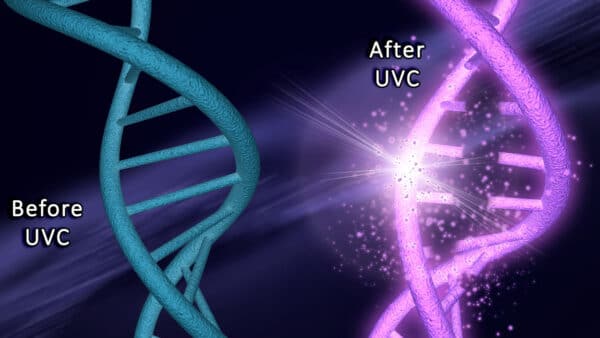The Discovery
In 1877 scientists first observed strong sunlight disinfecting water. British Physiologist Arthur Downes and scientist Thomas P. Blunt noticed that sugar water kept in the shade went cloudy as microorganisms grew in it, whereas the sugar water kept in direct sunlight remained completely clear. Using this knowledge, German Ophthalmologist Ernst Hertel determined 25 years later that light in the UV-C wavelength could inhibit the growth of pathogens.
UV Light In Disinfection Applications
The ability to artificially create ultraviolet light at the correct wavelengths with lamps gives us the power to help disinfect a variety of liquids as well as air and surfaces.

UV based disinfection processes (also known as germicidal irradiation) is a chemical-free disinfection method that uses short-wavelength ultraviolet (UV-C) light to inactivate microorganisms by disrupting their DNA, leaving them unable to perform vital cellular functions such as reproduction. At the 254nm wavelength, UV light can penetrate the cell wall of a microorganism, permanently altering the DNA structure within seconds and leaving no chemical by-products as a result.
Dosing
Precise and targeted ‘dosing’ is used to calculate the type of UV lamp needed for different applications. This includes how long different liquids, air or surfaces need to be exposed to the ultraviolet light in order for them to be safely disinfected. For example, medium-pressure UV lamps emit a wide disinfection wavelength at 200-320nm and are ideal for largescale commercial applications such as ballast water and wastewater treatment.
Dosing takes into account the UV intensity being given out from the lamps, the UV transmittance (UVT) of the water, air or surface (if applicable) and the amount of time the substance being disinfected is exposed to the UV light.
Ultraviolet Spectrum
Ultraviolet light occupies a very narrow range on the electromagnetic spectrum and even then it breaks down into different wavelengths that are shorter than visible light.
- UV-A: Longwave (315 – 400 nm) UV is the least harmful but can contribute to skin ageing and DNA damage. UV-A lamps are used for curing inks, adhesives and coatings.
- UV-B: Midwave (280 – 315 nm) UV is more dangerous and is responsible for burning the skin. UV-B lamps are also used for curing inks, specifically clear coatings and thin ink layers.
- UV-C: Shortwave (100 – 280 nm) UV is the most harmful and is used for water and air disinfection as it can render micro-organisms harmless.
- V: (400 – 700 nm) Visible light from violet – the shortest wavelength we can see with our own eyes – up to red, which is the longest visible wavelength before infrared.

Advantages of UV Light for Disinfection Applications
Ultraviolet light has many advantages over conventional methods for surface, air and water disinfection:
The majority of UV based disinfection systems require no chemicals, just correct dosage from the lamps – depending on the application some processes may still use chemicals but in much smaller amounts.
- There are no toxic chemicals or carcinogenic by-products left behind when UV based disinfection processes are used.
- UV technology disinfection systems are often smaller and easier to use than conventional systems, with affordable capital and operational costs.
- Ultraviolet light doesn’t alter the taste of liquid or food, which can happen with chemical or heat treatments.
- UV lamps and their disinfection systems are often safer for the personnel using them than chemical systems and eliminating the need to produce, store and transport dangerous and potentially toxic chemicals.
- UV lamps have a wide use. They can be used in processes to help disrupt the DNA of bacteria, moulds, spores and viruses.
- UV disinfection solutions inactivate pathogens that have developed a resistance to chlorine and other chemicals, such as cryptosporidium.